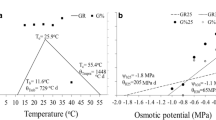Abstract
In beech (Fagus crenata Blume) forests on the Pacific Ocean side in Central Japan, snowpack depth is little and xeric conditions may prevail in winter, in contrast to heavy snow in beech forests on the Japan Sea side. The effects of such conditions during winter on the viability of beech seeds were studied at a beech forest on the Pacific Ocean side. Thickness and weight ratio of pericarp of beech seeds were significantly greater in populations on the Pacific Ocean side compared to the Japan Sea side, this apparently being related to snowpack depth in winter. During the initial stage of seed drying, the drying rate of seeds from the Fuji population (the Pacific Ocean side) was less than that from the Sumon population (the Japan Sea side), possibly due to the thicker pericarp. Germination percentage of seeds which dried to a water content as low as 7% d.w. did not decrease for either population, indicating desiccation tolerance of beech seeds. In the beech forest (University Forest at Yamanaka) on the Pacific Ocean side, water content of seeds sown below litter from both populations remained sufficient for viability during winter. Germinating seeds from the populations on the Japan Sea side were more desiccation-sensitive in early spring, compared to those from the Fuji population, partially due possibly to differences in pericarp thickness.
Similar content being viewed by others
Literature cited
Borghetti, M., Leonardi, S., Raschi, A., Snyderman, D., and Tognetti, R. (1993) Ecotypic variation of xylem embolism, phenological traits, growth parameters and allozyme characteristics inFagus sylvatica. Funct. Ecol. 7: 713–720.
Fujita, N. (1986) Structure and species composition of Japan-sea type and Pacific-Ocean-type beech forests. Plant Species Biol. 10: 1–13. (in Japanese with English summary).
Fukushima, T., Takasuna, H., Matsui, T., Nishio, T., Kyan, Y., and Tsunetomi, Y. (1995) New phytosociological classification of beech forests in Japan. Jpn. J. Ecol. 45: 79–98. (in Japanese with English summary).
Grime, J.P., and Jeffrey, D.W. (1965) Seedling establishment in vertical gradients of sunlight. J. Ecol. 53: 621–642.
Hagiwara, S. (1977) Cline of leaf area inFagus crenata. Plant Species Biol. 1: 39–51 (in Japanese).
Hara, M. (1983) A study of the regeneration process of a Japanese beech forest. Ecol. Rev. 20: 115–129.
Hara, M. (1985) Forest response to gap formation in a beech forest. Jpn. J. Ecol. 35: 337–343.
Harper, J.L., Lovell, P.H., and Moore, K.G. (1970)The shapes and sizes of seeds. Ann. Rev. Ecol. Syst. 54: 151–166.
Hashizume, H., Lee, J.H., and Yamamoto, F. (1996) Variation in the flushing time ofFagus crenata Blume among provenances and families. J. Jpn. For. Soc. 78: 363–368. (in Japanese with English summary).
Hiroki, S., and Matsubara, T. (1982) Ecological studies on the plants of Fagaceae III. Comparative studies on the seed and seedling stages. Jpn. J. Ecol. 32: 227–240 (in Japanese with English summary).
Hong, T.D., and Ellis, R.H. (1990) A comparison of maturation drying, germination, and desiccation tolerance between developing seeds ofAcer pseudoplatanus L. andAcer platanoides L. New Phytol. 116: 589–596.
Kaji, M., Sawada, H., Sasaki, K., Ohmura, K., and Ohkubo, T. (1992) Study on the regeneration dynamics of the natural forests in the Chichibu Mountains, Central Japan, I, Amounts of fallen nuts and survival of seedlings of Japanese beech (Fagus japonica Maxim.) in Japanese beech forests. Bull. Tokyo Univ. For. 87: 129–157 (in Japanese with English summary).
Kaji, M. and Nishitani, Y. (1996) Phenology ofFagus crenata from different origins. Establishment of the monitoring methods for climate change in forest regions (Report of the study supported by a grant for scientific research by Ministry of Education, Science and Culture, Japan). (in Japanese).
Maruyama, K., Tsukahara, M., and Kamitani, T. (1989) Ecological studies on natural beech forest (37) Gap regeneration of natural Japanese beech forest at Narumi and Hisonokura. Bull. Niigata Univ. For. 22: 13–33. (in Japanese with English summary).
Nakashizuka, T. (1983) Regeneration process of climax beech (Fagus crenata Blume) forests, III. Structure and development processes of sapling populations in different aged gaps. Jpn. J. Ecol. 33: 409–418.
Nakashizuka, T. (1987) Regeneration dynamics of beech forests in Japan. Vegetatio 69: 169–175.
Robert, E.H., and Ellis, R.H. (1989) Water and seed survival. Ann. Bot. 63: 39–52.
Salisbury, E.J. (1942) The reproductive capacity of plants. Bell, London.
Seiwa, K. and Kikuzawa, K. (1989) Seasonal growth patterns of seedling height in relation to seed mass in deciduous broad-leaved tree species. Jpn. J. Ecol. 39: 5–15 (in Japanese with English summary).
Shimano, K. and Okitsu, S. (1993) Regeneration of mixedFagus crenata-Fagus japonica forests in Mt. Mito, Okutama, west of Tokyo. Jpn. J. Ecol. 43: 13–20. (in Japanese with English summary).
Shimano, K. and Okitsu, S. (1994) Regeneration of naturalFagus crenata forests around the Kanto district. Jpn. J. Ecol. 44: 283–291 (in Japanese with English summary).
Shimano, K. and Masuzawa, T. (1995) Comparison of seed preservation ofFagus crenata Blume under different snow conditions. J. Jpn. For. Soc. 77: 79–82.
Society of Forest Environment (1972) Forest environment map of Japan, Annual precipitation and maximum snow depth.
Tognetti, R., Johnson, J.H., and Michelozzi, M. (1995) The response of European beech (Fagus sylvatica L.) seedlings from two Italian populations to drought and recovery. Trees 9: 348–354.
Yamamoto, S. (1989) Gap dynamics in climaxFagus crenata forest. Bot. Mag. Tokyo 102: 93–144.
Author information
Authors and Affiliations
About this article
Cite this article
Maruta, E., Kamitani, T., Okabe, M. et al. Desiccation-tolerance ofFagus crenata blume seeds from localities of different snowfall regime in central Japan. J. For. Res. 2, 45–50 (1997). https://doi.org/10.1007/BF02348262
Accepted:
Issue Date:
DOI: https://doi.org/10.1007/BF02348262




